Ziliang Chen
MM-CoT:A Benchmark for Probing Visual Chain-of-Thought Reasoning in Multimodal Models
Dec 09, 2025Abstract:The ability to perform Chain-of-Thought (CoT) reasoning marks a major milestone for multimodal models (MMs), enabling them to solve complex visual reasoning problems. Yet a critical question remains: is such reasoning genuinely grounded in visual evidence and logically coherent? Existing benchmarks emphasize generation but neglect verification, i.e., the capacity to assess whether a reasoning chain is both visually consistent and logically valid. To fill this gap, we introduce MM-CoT, a diagnostic benchmark specifically designed to probe the visual grounding and logical coherence of CoT reasoning in MMs. Instead of generating free-form explanations, models must select the sole event chain that satisfies two orthogonal constraints: (i) visual consistency, ensuring all steps are anchored in observable evidence, and (ii) logical coherence, ensuring causal and commonsense validity. Adversarial distractors are engineered to violate one of these constraints, exposing distinct reasoning failures. We evaluate leading vision-language models on MM-CoT and find that even the most advanced systems struggle, revealing a sharp discrepancy between generative fluency and true reasoning fidelity. MM-CoT shows low correlation with existing benchmarks, confirming that it measures a unique combination of visual grounding and logical reasoning. This benchmark provides a foundation for developing future models that reason not just plausibly, but faithfully and coherently within the visual world.
MM-OPERA: Benchmarking Open-ended Association Reasoning for Large Vision-Language Models
Oct 30, 2025Abstract:Large Vision-Language Models (LVLMs) have exhibited remarkable progress. However, deficiencies remain compared to human intelligence, such as hallucination and shallow pattern matching. In this work, we aim to evaluate a fundamental yet underexplored intelligence: association, a cornerstone of human cognition for creative thinking and knowledge integration. Current benchmarks, often limited to closed-ended tasks, fail to capture the complexity of open-ended association reasoning vital for real-world applications. To address this, we present MM-OPERA, a systematic benchmark with 11,497 instances across two open-ended tasks: Remote-Item Association (RIA) and In-Context Association (ICA), aligning association intelligence evaluation with human psychometric principles. It challenges LVLMs to resemble the spirit of divergent thinking and convergent associative reasoning through free-form responses and explicit reasoning paths. We deploy tailored LLM-as-a-Judge strategies to evaluate open-ended outputs, applying process-reward-informed judgment to dissect reasoning with precision. Extensive empirical studies on state-of-the-art LVLMs, including sensitivity analysis of task instances, validity analysis of LLM-as-a-Judge strategies, and diversity analysis across abilities, domains, languages, cultures, etc., provide a comprehensive and nuanced understanding of the limitations of current LVLMs in associative reasoning, paving the way for more human-like and general-purpose AI. The dataset and code are available at https://github.com/MM-OPERA-Bench/MM-OPERA.
Understanding Hardness of Vision-Language Compositionality from A Token-level Causal Lens
Oct 30, 2025Abstract:Contrastive Language-Image Pre-training (CLIP) delivers strong cross modal generalization by aligning images and texts in a shared embedding space, yet it persistently fails at compositional reasoning over objects, attributes, and relations often behaving like a bag-of-words matcher. Prior causal accounts typically model text as a single vector, obscuring token-level structure and leaving core phenomena-such as prompt sensitivity and failures on hard negatives unexplained. We address this gap with a token-aware causal representation learning (CRL) framework grounded in a sequential, language-token SCM. Our theory extends block identifiability to tokenized text, proving that CLIP's contrastive objective can recover the modal-invariant latent variable under both sentence-level and token-level SCMs. Crucially, token granularity yields the first principled explanation of CLIP's compositional brittleness: composition nonidentifiability. We show the existence of pseudo-optimal text encoders that achieve perfect modal-invariant alignment yet are provably insensitive to SWAP, REPLACE, and ADD operations over atomic concepts, thereby failing to distinguish correct captions from hard negatives despite optimizing the same training objective as true-optimal encoders. The analysis further links language-side nonidentifiability to visual-side failures via the modality gap and shows how iterated composition operators compound hardness, motivating improved negative mining strategies.
An Exhaustive DPLL Approach to Model Counting over Integer Linear Constraints with Simplification Techniques
Sep 17, 2025Abstract:Linear constraints are one of the most fundamental constraints in fields such as computer science, operations research and optimization. Many applications reduce to the task of model counting over integer linear constraints (MCILC). In this paper, we design an exact approach to MCILC based on an exhaustive DPLL architecture. To improve the efficiency, we integrate several effective simplification techniques from mixed integer programming into the architecture. We compare our approach to state-of-the-art MCILC counters and propositional model counters on 2840 random and 4131 application benchmarks. Experimental results show that our approach significantly outperforms all exact methods in random benchmarks solving 1718 instances while the state-of-the-art approach only computes 1470 instances. In addition, our approach is the only approach to solve all 4131 application instances.
Learning to See and Act: Task-Aware View Planning for Robotic Manipulation
Aug 07, 2025Abstract:Recent vision-language-action (VLA) models for multi-task robotic manipulation commonly rely on static viewpoints and shared visual encoders, which limit 3D perception and cause task interference, hindering robustness and generalization. In this work, we propose Task-Aware View Planning (TAVP), a framework designed to overcome these challenges by integrating active view planning with task-specific representation learning. TAVP employs an efficient exploration policy, accelerated by a novel pseudo-environment, to actively acquire informative views. Furthermore, we introduce a Mixture-of-Experts (MoE) visual encoder to disentangle features across different tasks, boosting both representation fidelity and task generalization. By learning to see the world in a task-aware way, TAVP generates more complete and discriminative visual representations, demonstrating significantly enhanced action prediction across a wide array of manipulation challenges. Extensive experiments on RLBench tasks show that our proposed TAVP model achieves superior performance over state-of-the-art fixed-view approaches. Visual results and code are provided at: https://hcplab-sysu.github.io/TAVP.
Beyond the Destination: A Novel Benchmark for Exploration-Aware Embodied Question Answering
Mar 14, 2025



Abstract:Embodied Question Answering (EQA) is a challenging task in embodied intelligence that requires agents to dynamically explore 3D environments, actively gather visual information, and perform multi-step reasoning to answer questions. However, current EQA approaches suffer from critical limitations in exploration efficiency, dataset design, and evaluation metrics. Moreover, existing datasets often introduce biases or prior knowledge, leading to disembodied reasoning, while frontier-based exploration strategies struggle in cluttered environments and fail to ensure fine-grained exploration of task-relevant areas. To address these challenges, we construct the EXPloration-awaRe Embodied queStion anSwering Benchmark (EXPRESS-Bench), the largest dataset designed specifically to evaluate both exploration and reasoning capabilities. EXPRESS-Bench consists of 777 exploration trajectories and 2,044 question-trajectory pairs. To improve exploration efficiency, we propose Fine-EQA, a hybrid exploration model that integrates frontier-based and goal-oriented navigation to guide agents toward task-relevant regions more effectively. Additionally, we introduce a novel evaluation metric, Exploration-Answer Consistency (EAC), which ensures faithful assessment by measuring the alignment between answer grounding and exploration reliability. Extensive experimental comparisons with state-of-the-art EQA models demonstrate the effectiveness of our EXPRESS-Bench in advancing embodied exploration and question reasoning.
De-singularity Subgradient for the $q$-th-Powered $\ell_p$-Norm Weber Location Problem
Dec 20, 2024Abstract:The Weber location problem is widely used in several artificial intelligence scenarios. However, the gradient of the objective does not exist at a considerable set of singular points. Recently, a de-singularity subgradient method has been proposed to fix this problem, but it can only handle the $q$-th-powered $\ell_2$-norm case ($1\leqslant q<2$), which has only finite singular points. In this paper, we further establish the de-singularity subgradient for the $q$-th-powered $\ell_p$-norm case with $1\leqslant q\leqslant p$ and $1\leqslant p<2$, which includes all the rest unsolved situations in this problem. This is a challenging task because the singular set is a continuum. The geometry of the objective function is also complicated so that the characterizations of the subgradients, minimum and descent direction are very difficult. We develop a $q$-th-powered $\ell_p$-norm Weiszfeld Algorithm without Singularity ($q$P$p$NWAWS) for this problem, which ensures convergence and the descent property of the objective function. Extensive experiments on six real-world data sets demonstrate that $q$P$p$NWAWS successfully solves the singularity problem and achieves a linear computational convergence rate in practical scenarios.
LW-DETR: A Transformer Replacement to YOLO for Real-Time Detection
Jun 05, 2024



Abstract:In this paper, we present a light-weight detection transformer, LW-DETR, which outperforms YOLOs for real-time object detection. The architecture is a simple stack of a ViT encoder, a projector, and a shallow DETR decoder. Our approach leverages recent advanced techniques, such as training-effective techniques, e.g., improved loss and pretraining, and interleaved window and global attentions for reducing the ViT encoder complexity. We improve the ViT encoder by aggregating multi-level feature maps, and the intermediate and final feature maps in the ViT encoder, forming richer feature maps, and introduce window-major feature map organization for improving the efficiency of interleaved attention computation. Experimental results demonstrate that the proposed approach is superior over existing real-time detectors, e.g., YOLO and its variants, on COCO and other benchmark datasets. Code and models are available at (https://github.com/Atten4Vis/LW-DETR).
A De-singularity Subgradient Approach for the Extended Weber Location Problem
May 11, 2024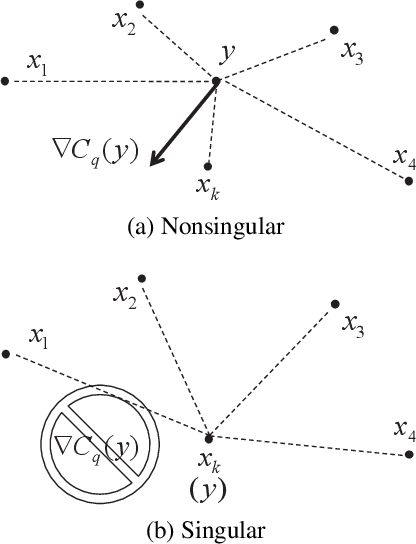

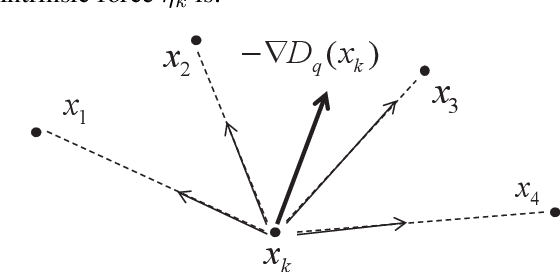
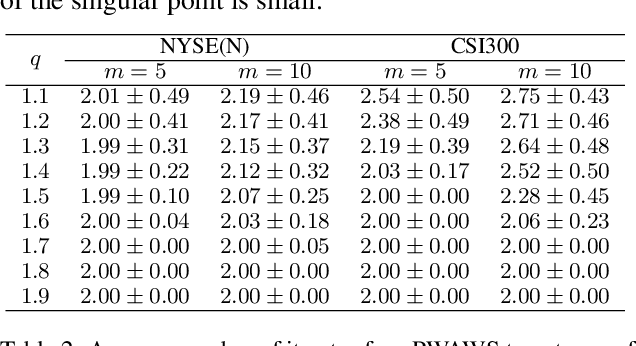
Abstract:The extended Weber location problem is a classical optimization problem that has inspired some new works in several machine learning scenarios recently. However, most existing algorithms may get stuck due to the singularity at the data points when the power of the cost function $1\leqslant q<2$, such as the widely-used iterative Weiszfeld approach. In this paper, we establish a de-singularity subgradient approach for this problem. We also provide a complete proof of convergence which has fixed some incomplete statements of the proofs for some previous Weiszfeld algorithms. Moreover, we deduce a new theoretical result of superlinear convergence for the iteration sequence in a special case where the minimum point is a singular point. We conduct extensive experiments in a real-world machine learning scenario to show that the proposed approach solves the singularity problem, produces the same results as in the non-singularity cases, and shows a reasonable rate of linear convergence. The results also indicate that the $q$-th power case ($1<q<2$) is more advantageous than the $1$-st power case and the $2$-nd power case in some situations. Hence the de-singularity subgradient approach is beneficial to advancing both theory and practice for the extended Weber location problem.
Diagnosing and Rectifying Fake OOD Invariance: A Restructured Causal Approach
Dec 15, 2023

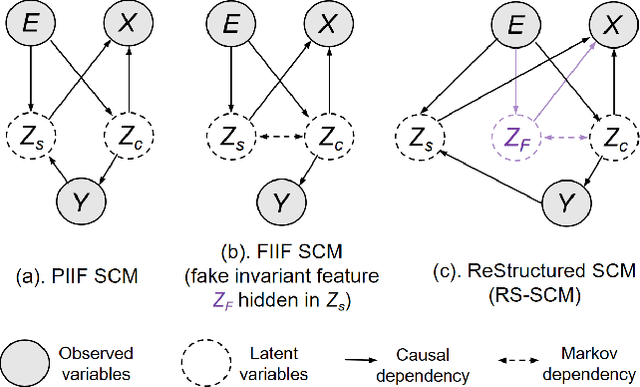
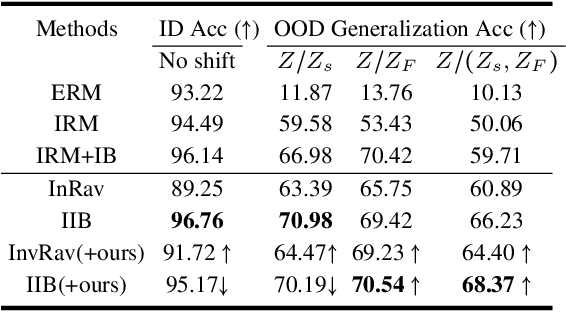
Abstract:Invariant representation learning (IRL) encourages the prediction from invariant causal features to labels de-confounded from the environments, advancing the technical roadmap of out-of-distribution (OOD) generalization. Despite spotlights around, recent theoretical results verified that some causal features recovered by IRLs merely pretend domain-invariantly in the training environments but fail in unseen domains. The \emph{fake invariance} severely endangers OOD generalization since the trustful objective can not be diagnosed and existing causal surgeries are invalid to rectify. In this paper, we review a IRL family (InvRat) under the Partially and Fully Informative Invariant Feature Structural Causal Models (PIIF SCM /FIIF SCM) respectively, to certify their weaknesses in representing fake invariant features, then, unify their causal diagrams to propose ReStructured SCM (RS-SCM). RS-SCM can ideally rebuild the spurious and the fake invariant features simultaneously. Given this, we further develop an approach based on conditional mutual information with respect to RS-SCM, then rigorously rectify the spurious and fake invariant effects. It can be easily implemented by a small feature selection subnet introduced in the IRL family, which is alternatively optimized to achieve our goal. Experiments verified the superiority of our approach to fight against the fake invariant issue across a variety of OOD generalization benchmarks.
 Add to Chrome
Add to Chrome Add to Firefox
Add to Firefox Add to Edge
Add to Edge